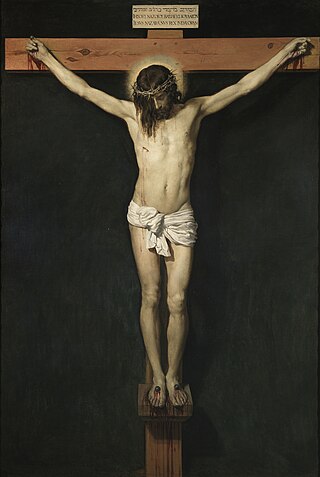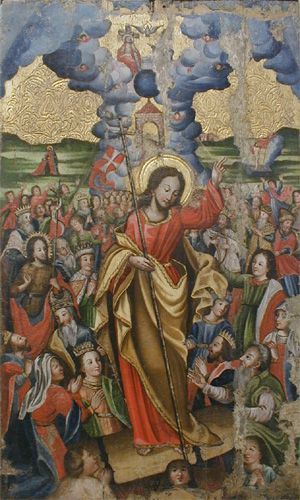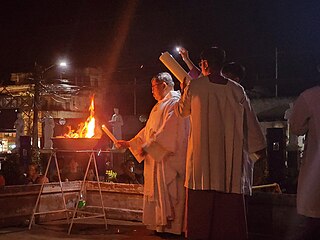
Egg tossing or egg throwing is a game associated with Easter. Various types of such games exist, common ones involve throwing an egg so that it lands on the ground without breaking. Such a contest may be known as an egg toss.

Egg tossing or egg throwing is a game associated with Easter. Various types of such games exist, common ones involve throwing an egg so that it lands on the ground without breaking. Such a contest may be known as an egg toss.
In Christianity, for the celebration of Eastertide, Easter eggs symbolize the empty tomb of Jesus, from which he was resurrected. [1] [2] [3] Additionally, eggs carry a Trinitarian significance, with shell, yolk, and albumen being three parts of one egg. [4] During Lent, the season of repentance that precedes Easter, eggs along with meat, lacticinia, and wine are foods that are traditionally abstained from, a practice that continues in Eastern Christianity and among certain Western Christian congregations that do the Daniel Fast. [5] [6]
In medieval Britain there was an egg throwing festival held in the churches at Easter. The priest would give out one hard-boiled egg which was tossed around the nave of the church and the choirboy who was holding the egg when the clock struck twelve would get to keep it. [7]
In one version of the game the idea is to toss an egg so it falls on the ground without breaking. This is possible on, for example, grassy meadows. [8] In Germany, children invented a way to spin the egg during the toss so that it lands on its tip still spinning. [8]
Dutch children play a game called "egg sales" in which one child sells an egg to another. The new owner then throws the egg in the grass and if it does not break it must be returned to the seller. [8]
Egg tossing is also known as a team competition with basically the following rules, although the exact details may vary. One member of a two-person team tosses an egg to another. If the egg does not break, they step apart and the toss is repeated. The contest continues until one egg is left unbroken. (A popular variation uses water balloons.)
On July 4, 2011, in Grangeville, Idaho, the world record for the number of persons participating in an egg toss was set, with 2,130 persons participating.
An egg throwing feat was recorded in the Guinness Book of World Records : on November 12, 1978, Johnny Dell Foley successfully tossed a fresh hen's egg for a distance of 323 ft 2in (98.51m) to a Keith Thomas at Jewett, Texas. [9] The record was undefeated until at least 1999. Since 2000 the feat is no longer listed in the book.
Since the world record in Egg Throwing has not been recorded in the Guinness Book of World Records since 1999, the World Egg Throwing Federation, based in Swaton, England, now certifies official world records. The world record in Egg Throwing was held until May 19, 2013 by the Dutchmen Andries Smink and Hillebrand Visser with a certified distance of throw and catch of 69.5 meters (228.01837 ft) thrown on August 17, 2012. May 19, 2013 the Irish 'Wild' Willie O'Donevan and 'Big' Warren McElhone set a new world record at the Irish National Open of 71.2 meters.
WETF World Records:
The Hagerstown Suns have hosted the annual National Egg Toss Championship since 2005. [10] [11]
A World Egg Throwing Federation championship is held in Swaton, England each year on the last Sunday in June since 2006. [12]

Easter eggs, also called Paschal eggs, are eggs that are decorated for the Christian holiday of Easter, which celebrates the resurrection of Jesus. As such, Easter eggs are commonly used during the season of Eastertide. The oldest tradition, which continues to be used in Central and Eastern Europe, is to dye and paint chicken eggs.

Easter, also called Pascha or Resurrection Sunday, is a Christian festival and cultural holiday commemorating the resurrection of Jesus from the dead, described in the New Testament as having occurred on the third day of his burial following his crucifixion by the Romans at Calvary c. 30 AD. It is the culmination of the Passion of Jesus Christ, preceded by Lent, a 40-day period of fasting, prayer, and penance.

Great Lent, or the Great Fast, is the most important fasting season of the church year within many denominations of Eastern Christianity. It is intended to prepare Christians for the greatest feast of the church year, Pascha (Easter).

The Easter Bunny is a folkloric figure and symbol of Easter, depicted as a rabbit—sometimes dressed with clothes—bringing Easter eggs. Originating among German Lutherans, the "Easter Hare" originally played the role of a judge, evaluating whether children were good or disobedient in behavior at the start of the season of Eastertide, similar to the "naughty or nice" list made by Santa Claus. As part of the legend, the creature carries colored eggs in its basket, as well as candy, and sometimes toys, to the homes of children. As such, the Easter Bunny again shows similarities to Santa and Christmas by bringing gifts to children on the night before a holiday. The custom was first mentioned in Georg Franck von Franckenau's De ovis paschalibus in 1682, referring to a German tradition of an Easter Hare bringing eggs for the children.

Good Friday is a Christian holy day observing the crucifixion of Jesus and his death at Calvary. It is observed during Holy Week as part of the Paschal Triduum. It is also known as Black Friday, Holy Friday, Great Friday, Good Friday of the Passion of the Lord,Great and Holy Friday.

Holy Week is the most sacred week in the liturgical year in Christianity. For all Christian traditions, it is a moveable observance. In Eastern Christianity, which also calls it Great Week, it is the week following Great Lent and Lazarus Saturday, starting on the evening of Palm Sunday and concluding on the evening of Great Saturday. In Western Christianity, Holy Week is the sixth and last week of Lent, beginning with Palm Sunday and concluding on Holy Saturday.

Holy Saturday, also known as Great and Holy Saturday, Low Saturday, the Great Sabbath, Hallelujah Saturday, Saturday of the Glory, Sábado de Gloria, and Black Saturday or Easter Eve, and called "Joyous Saturday", "the Saturday of Light", and "Mega Sabbatun" among Coptic Christians, is the final day of Holy Week, between Good Friday and Easter Sunday, when Christians prepare for the latter.

Egg rolling, or an Easter egg roll is a traditional game played with eggs at Easter. Different nations have different versions of the game, usually played with hard-boiled, decorated eggs.

Eastertide or Paschaltide is a festal season in the liturgical year of Christianity that focuses on celebrating the Resurrection of Jesus Christ. Preceded by Lent, it begins on Easter Sunday, which initiates Easter Week in Western Christianity, and Bright Week in Eastern Christianity.

The Easter Vigil, also called the Paschal Vigil, the Great Vigil of Easter, or Holy Saturday in the Easter Vigil on the Holy Night of Easter is a liturgy held in traditional Christian churches as the first official celebration of the Resurrection of Jesus. Historically, it is during this liturgy that people are baptized and that adult catechumens are received into full communion with the Church. It is held in the hours of darkness between sunset on Holy Saturday and sunrise on Easter Day – most commonly in the evening of Holy Saturday or midnight – and is the first celebration of Easter, days traditionally being considered to begin at sunset.

The Copts, who belong mostly to the Coptic Orthodox Church, observe fasting periods according to the Coptic calendar. In Coptic Orthodox Christianity, fasting is defined as going without water and food from midnight to sunset; after that time, the consumption of water and one vegetarian meal is permitted. The fasting periods of Coptic Christians are exceeded by no other Christian denomination except the Orthodox Tewahedo. Out of the 365 days of the year, Copts often fast between 210 and 240 days. This means that Copts abstain from all animal products for up to two-thirds of each year. Coptic Orthodox fasts have evolved over time to become more lengthy and severe. A lifestyle involving such fasts may have contributed to the pacifist mindset of the Coptic people for centuries. Married couples refrain from sexual relations during Lent "to give themselves time for fasting and prayer".

An Easter basket, also known as a Paschal basket, is a basket used during the Christian Easter season. In different times and places across the various Christian branches, Easter baskets have served different purposes. For adults, Easter baskets may have deep religious significance and be blessed by a priest. In modern times, the baskets may be filled with food or toys and presented to children as gifts. They are also used by children to gather hidden eggs during egg hunts.

An egg hunt is a treasure hunt played at Easter during which children look for hidden decorated eggs or Easter eggs. Real hard-boiled eggs, which are typically dyed or painted, artificial eggs made of plastic filled with chocolate or candies, or foil-wrapped egg-shaped chocolates of various sizes are hidden in various places; as many people give up sweets as their Lenten sacrifice, individuals consume them after having abstained from them during the preceding forty days of Lent.

Egg tapping, or also known as egg fight, egg knocking, knocky eggs, egg pacqueing, egg boxing, egg picking, egg chucking, egg wars, egg jarping, pecking, or epper is a traditional Easter game. In English folk traditions, the game has variously been known as "shackling", "jarping" or "dumping".

Lent is the solemn Christian religious observance in the liturgical year commemorating the 40 days Jesus spent fasting in the desert and enduring temptation by Satan, according to the Gospels of Matthew, Mark and Luke, before beginning his public ministry. Lent is usually observed in the Catholic, Lutheran, Moravian, Anglican, United Protestant and Orthodox Christian traditions, among others. Some Anabaptist, Baptist, Methodist, Reformed, and nondenominational Christian churches also observe Lent, although many churches in these traditions do not.

Easter traditions are customs and practices that are followed in various cultures and communities around the world to celebrate Easter, which is the central feast in Christianity, commemorating the resurrection of Jesus. The Easter season is seen as a time of celebration and feasting, in contrast to the antecedent season of Lent, which is a time of penitence and fasting.

A German tradition of decorating trees and bushes with Easter eggs is known as the Ostereierbaum, or Easter egg tree. A notable example is the Saalfelder Ostereierbaum in Saalfeld, Thuringia.

Clean Monday, also known as Pure Monday, Green Monday or simply Monday of Lent is the first day of Great Lent throughout Eastern Christianity and is a moveable feast, falling on the sixth Monday before Palm Sunday which begins Holy Week, preceding Pascha Sunday (Easter).

The holiday of Easter is associated with various Easter customs and foodways. Preparing, coloring, and decorating Easter eggs is one such popular tradition. Lamb is eaten in many countries, mirroring the Jewish Passover meal.
Easter eggs are used as a Christian symbol to represent the empty tomb. The outside of the egg looks dead but inside there is new life, which is going to break out. The Easter egg is a reminder that Jesus will rise from His tomb and bring new life. Orthodox Christians dye boiled eggs red to make red Easter eggs that represent the blood of Christ shed for the sins of the world.
Just so, on that first Easter morning, Jesus came to life and walked out of the tomb, and left it, as it were, an empty shell. Just so, too, when the Christian dies, the body is left in the grave, an empty shell, but the soul takes wings and flies away to be with God. Thus you see that though an egg seems to be as dead as a stone, yet it really has life in it; and also it is like Christ's dead body, which was raised to life again. This is the reason we use eggs on Easter. (In days past some used to color the eggs red, so as to show the kind of death by which Christ died,-a bloody death.)
Red eggs are given to Orthodox Christians after the Easter Liturgy. They crack their eggs against each other's. The cracking of the eggs symbolizes a wish to break away from the bonds of sin and misery and enter the new life issuing from Christ's resurrection.
In some cases, entire churches do the Daniel Fast together during Lent. The idea strikes a chord in Methodist traditions, which trace their heritage to John Wesley, a proponent of fasting. Leaders in the African Methodist Episcopal Church have urged churchgoers to do the Daniel Fast together, and congregations from Washington to Pennsylvania and Maryland have joined in.
Many parishioners at St. Philip Neri are participating in the Daniel fast, a religious diet program based on the fasting experiences of the Old Testament prophet Daniel. ... participating parishioners started the fast Ash Wednesday (Feb. 10) and will continue through Holy Saturday, the day before Easter Sunday.